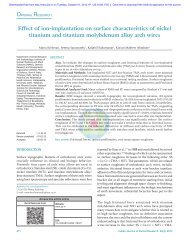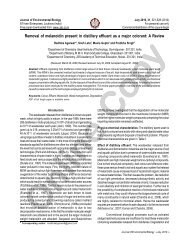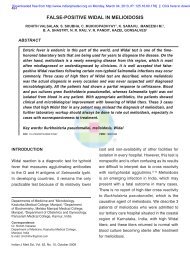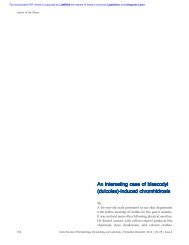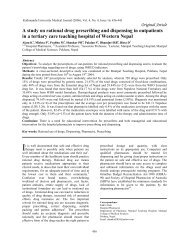Standard WHO-ORS Versus Reduced-osmolarity ORS in the ...
Standard WHO-ORS Versus Reduced-osmolarity ORS in the ...
Standard WHO-ORS Versus Reduced-osmolarity ORS in the ...
You also want an ePaper? Increase the reach of your titles
YUMPU automatically turns print PDFs into web optimized ePapers that Google loves.
J HEALTH POPUL NUTR 2006 Mar;24(1):107-112 © 2006 ICDDR,B: Centre for Health and Population Research<br />
ISSN 1606-0997 $ 5.00+0.20<br />
<strong>Standard</strong> <strong>WHO</strong>-<strong>ORS</strong> <strong>Versus</strong> <strong>Reduced</strong>-<strong>osmolarity</strong><br />
<strong>ORS</strong> <strong>in</strong> <strong>the</strong> Management of Cholera Patients<br />
Sri Pandam Pulungsih1, Nara<strong>in</strong> H. Punjabi2, Kustedy Rafli1, Atti Rifajati1, Swiandy Kumala1, Cyrus H. Simanjuntak3, Yuwono4, Murad Lesmana5, Decy Subekti2, Sutoto† 1, and Olivier Fonta<strong>in</strong>e6 1Infectious Diseases Hospital Prof. Dr. Sulianti Saroso, Jakarta, Indonesia (†Dr. Sutoto<br />
passed away <strong>in</strong> 2003), 2U.S. Naval Medical Research Unit No. 2, Jakarta, 3National Institute<br />
of Health Research and Development, Jakarta, 4Directorate General of Center for Disease<br />
Control and Environmental Health, M<strong>in</strong>istry of Health, Jakarta, 5Medical Faculty, Trisakti<br />
University, Jakarta, and 6Department of Child and Adolescent Health and Development,<br />
World Health Organization, Geneva 27, Switzerland<br />
ABSTRACT<br />
The study compared <strong>the</strong> safety and efficacy of an oral rehydration salts (<strong>ORS</strong>) solution, conta<strong>in</strong><strong>in</strong>g 75<br />
mmol/L of sodium and glucose each, with <strong>the</strong> standard World Health Organization (<strong>WHO</strong>)-<strong>ORS</strong> solution<br />
<strong>in</strong> <strong>the</strong> management of ongo<strong>in</strong>g fluid losses, after <strong>in</strong>itial <strong>in</strong>travenous rehydration to correct dehydration.<br />
The study was conducted among patients aged 12-60 years hospitalized with diarrhoea due to cholera.<br />
One hundred seventy-six patients who were hospitalized with acute diarrhoea and signs of severe dehydration<br />
were rehydrated <strong>in</strong>travenously and <strong>the</strong>n randomly assigned to receive ei<strong>the</strong>r standard <strong>ORS</strong> solution<br />
(311 mmol/L) or reduced-<strong>osmolarity</strong> <strong>ORS</strong> solution (245 mmol/L). Intakes and outputs were measured<br />
every six hours until <strong>the</strong> cessation of diarrhoea. Dur<strong>in</strong>g ma<strong>in</strong>tenance <strong>the</strong>rapy, stool output, <strong>in</strong>take of<br />
<strong>ORS</strong> solution, duration of diarrhoea, and <strong>the</strong> need for unscheduled adm<strong>in</strong>istration of <strong>in</strong>travenous fluids<br />
were similar <strong>in</strong> <strong>the</strong> two treatment groups. The type of <strong>ORS</strong> solution that <strong>the</strong> patients received did not<br />
affect <strong>the</strong> mean serum sodium concentration at 24 hours after randomization and <strong>the</strong> relative risk of<br />
development of hyponatraemia. However, patients treated with reduced-<strong>osmolarity</strong> <strong>ORS</strong> solution had<br />
a significantly lower volume of vomit<strong>in</strong>g and significantly higher ur<strong>in</strong>e output than those treated with<br />
standard <strong>WHO</strong>-<strong>ORS</strong> solution. <strong>Reduced</strong>-<strong>osmolarity</strong> <strong>ORS</strong> solution was as efficacious as standard <strong>WHO</strong>-<br />
<strong>ORS</strong> solution <strong>in</strong> <strong>the</strong> management of cholera patients. The results <strong>in</strong>dicate that reduced-<strong>osmolarity</strong> <strong>ORS</strong><br />
solution is also as safe as standard <strong>WHO</strong>-<strong>ORS</strong> solution. However, because of <strong>the</strong> limited sample size <strong>in</strong><br />
<strong>the</strong> study, <strong>the</strong> results will have to be confirmed <strong>in</strong> trials, <strong>in</strong>volv<strong>in</strong>g a larger number of patients.<br />
Key words: Diarrhoea; Cholera; Oral rehydration solutions; Rehydration; Dehydration; Osmolar concentration;<br />
Randomized controlled trials; Double-bl<strong>in</strong>d method; Comparative studies; Indonesia<br />
INTRODUCTION<br />
The discovery of oral rehydration salts (<strong>ORS</strong>) solution<br />
for <strong>the</strong> treatment of dehydration due to diarrhoea is considered<br />
to be one of <strong>the</strong> greatest achievements of medical<br />
research <strong>in</strong> <strong>the</strong> 20th century (1). S<strong>in</strong>ce it was recommended<br />
by <strong>the</strong> World Health Organization (<strong>WHO</strong>) <strong>in</strong><br />
Correspondence and repr<strong>in</strong>t requests should be addressed to:<br />
Dr. Nara<strong>in</strong> H. Punjabi<br />
U.S. Naval Medical Research Unit No. 2<br />
Jakarta 10560<br />
Indonesia<br />
Email: nara<strong>in</strong>@namru2.org<br />
Fax: (62-21) 420-7854/424-4507<br />
1978 for <strong>the</strong> management of all types of diarrhoea <strong>in</strong> all<br />
age-groups, numerous studies have been undertaken to<br />
develop an 'improved' <strong>ORS</strong>. The goal was to discover<br />
a product that would be at least as safe and effective as<br />
standard <strong>ORS</strong> solution for prevent<strong>in</strong>g or treat<strong>in</strong>g dehydration<br />
from all types of diarrhoea but which, <strong>in</strong> addition,<br />
would reduce stool output or have o<strong>the</strong>r important cl<strong>in</strong>ical<br />
benefits. One approach has emphasized reduc<strong>in</strong>g <strong>the</strong><br />
<strong>osmolarity</strong> of <strong>ORS</strong> solution to avoid possible adverse<br />
effects of hypertonicity on net fluid absorption. This was<br />
done by reduc<strong>in</strong>g glucose and salt (NaCl) concentrations<br />
<strong>in</strong> <strong>the</strong> solution (2-10). Results of studies conducted on
108<br />
J Health Popul Nutr Mar 2006<br />
children with non-cholera diarrhoea and comparison of<br />
this reduced-<strong>osmolarity</strong> <strong>ORS</strong> solution with <strong>the</strong> standard<br />
<strong>WHO</strong>-<strong>ORS</strong> solution showed that reduced-<strong>osmolarity</strong><br />
<strong>ORS</strong> solution significantly reduced stool output, vomit<strong>in</strong>g,<br />
and <strong>the</strong> need for unscheduled <strong>in</strong>travenous <strong>in</strong>fusion<br />
(7). Besides, reduced-<strong>osmolarity</strong> <strong>ORS</strong> solution also significantly<br />
decreased mean serum sodium concentration<br />
at 24 hours. However, all cases of hyponatraemia reported<br />
<strong>in</strong> <strong>the</strong>se studies were asymptomatic. Based on <strong>the</strong>se results,<br />
it appears that reduced-<strong>osmolarity</strong> <strong>ORS</strong> solution,<br />
conta<strong>in</strong><strong>in</strong>g a reduced amount of sodium and glucose, had<br />
beneficial effects on <strong>the</strong> cl<strong>in</strong>ical course of diarrhoea and<br />
is as safe as <strong>the</strong> standard <strong>WHO</strong>-<strong>ORS</strong> solution for use <strong>in</strong><br />
acute <strong>in</strong>fantile diarrhoea (7).<br />
These results, however, raised some concerns about<br />
<strong>the</strong> safety and efficacy of us<strong>in</strong>g reduced-<strong>osmolarity</strong> <strong>ORS</strong><br />
solution for <strong>the</strong> treatment of cholera patients as <strong>the</strong> faecal<br />
concentration of sodium is higher <strong>in</strong> cholera than <strong>in</strong><br />
non-cholera diarrhoea (7). A reduced-<strong>osmolarity</strong> <strong>ORS</strong><br />
solution, conta<strong>in</strong><strong>in</strong>g 75 mmol/L of sodium <strong>in</strong>stead of 90<br />
mmol/L, might not allow full replacement of sodium<br />
lost, possibly lead<strong>in</strong>g to an <strong>in</strong>crease <strong>in</strong> <strong>ORS</strong> <strong>in</strong>take, an<br />
<strong>in</strong>crease <strong>in</strong> <strong>the</strong> need for <strong>in</strong>travenous <strong>the</strong>rapy, and a<br />
higher risk of hyponatraemia. We, <strong>the</strong>refore, conducted<br />
a double-bl<strong>in</strong>d randomized cl<strong>in</strong>ical trial to compare <strong>the</strong><br />
efficacy and safety of <strong>the</strong> standard <strong>WHO</strong>-<strong>ORS</strong> solution<br />
with that of reduced-<strong>osmolarity</strong> <strong>ORS</strong> solution <strong>in</strong> patients<br />
(mostly adults) with dehydration due to Vibrio cholerae<br />
O1.<br />
MATERIALS AND METHODS<br />
The study was conducted at <strong>the</strong> Infectious Diseases Hospital<br />
(IDH) Prof. Dr. Sulianti Saroso, Jakarta, Indonesia.<br />
Patients aged 12 years or older are admitted to <strong>the</strong> adult<br />
ward <strong>in</strong> this hospital. In this study, patients aged 12-60<br />
years with __ (a) acute watery diarrhoea for less than 24<br />
hours prior to admission, (b) cl<strong>in</strong>ical signs of severe dehydration<br />
accord<strong>in</strong>g to <strong>the</strong> <strong>WHO</strong> guidel<strong>in</strong>es (11), (c)<br />
stool output of less than 5 g/kg.h dur<strong>in</strong>g <strong>the</strong> <strong>in</strong>itial <strong>in</strong>travenous<br />
<strong>in</strong>fusion, and (d) no visible blood <strong>in</strong> stool __ were<br />
enrolled <strong>in</strong> <strong>the</strong> study after obta<strong>in</strong><strong>in</strong>g verbal consent from<br />
patients or from <strong>the</strong>ir guardians if <strong>the</strong>y were not <strong>in</strong><br />
condition to provide consent due to <strong>the</strong>ir mental status<br />
condition at <strong>the</strong> time of enrollment <strong>in</strong> <strong>the</strong> study. Pregnant<br />
women and patients who had systemic <strong>in</strong>fections<br />
or o<strong>the</strong>r diseases requir<strong>in</strong>g specific additional treatment<br />
were excluded. Patients with negative stool/rectal swab<br />
culture for V. cholerae O1 were also excluded dur<strong>in</strong>g<br />
<strong>the</strong> f<strong>in</strong>al analysis. All patients were <strong>in</strong>itially treated with<br />
<strong>in</strong>travenous <strong>in</strong>fusion with R<strong>in</strong>ger's lactate solution given<br />
at a rate of 110 mL/kg plus replacement of ongo<strong>in</strong>g losses,<br />
Pulungsih SP et al.<br />
until blood pressure and pulse returned to normal and<br />
<strong>the</strong>y were able to tolerate oral fluids. This procedure<br />
usually takes 6-8 hours at <strong>the</strong> IDH, Jakarta, and is slower<br />
than <strong>in</strong> o<strong>the</strong>r rehydration centres. After <strong>in</strong>itial <strong>in</strong>travenous<br />
rehydration and provided <strong>the</strong>y met <strong>the</strong> <strong>in</strong>clusion<br />
criteria, <strong>the</strong>se patients were enrolled <strong>in</strong> <strong>the</strong> study and<br />
randomly assigned to one of <strong>the</strong> two treatment groups __<br />
reduced-<strong>osmolarity</strong> <strong>ORS</strong> solution or standard <strong>WHO</strong>-<br />
<strong>ORS</strong> solution (Table 1). The randomization list was established<br />
at <strong>the</strong> <strong>WHO</strong> <strong>in</strong> Geneva, with random permuted<br />
blocks of variable length (6-12 subjects per block). The<br />
packets of reduced-<strong>osmolarity</strong> <strong>ORS</strong> solution and of<br />
standard <strong>ORS</strong> solution, identical <strong>in</strong> appearance and<br />
packaged <strong>in</strong> identical sachets, were arranged <strong>in</strong> a sequence<br />
correspond<strong>in</strong>g to <strong>the</strong> master randomization code, numbered<br />
sequentially, and <strong>the</strong>n sent to Indonesia. Fifteen<br />
packets were assigned to each patient. Rehydration <strong>the</strong>rapy<br />
was conducted with <strong>the</strong> assigned <strong>ORS</strong> solution on<br />
Table 1. Composition of oral rehydration solutions<br />
<strong>Reduced</strong>-<br />
<strong>Standard</strong><br />
Composition <strong>osmolarity</strong><br />
<strong>WHO</strong>-<strong>ORS</strong> †<br />
<strong>ORS</strong> *<br />
Glucose (mmol/L) 75 111<br />
Sodium (mmol/L) 75 90<br />
Potassium (mmol/L) 20 20<br />
Chloride (mmol/L) 65 80<br />
Citrate (mmol/L) 10 10<br />
Osmolarity (mmol/L) 245 311<br />
*Dispensed <strong>in</strong> powder form with <strong>the</strong> follow<strong>in</strong>g <strong>in</strong>gredients<br />
(all measured <strong>in</strong> g/L): sodium chloride _ 2.6,<br />
trisodium citrate _ 2.9, potassium chloride _ 1.5, and<br />
glucose _ 13.5<br />
† Dispensed <strong>in</strong> powder form with <strong>the</strong> follow<strong>in</strong>g <strong>in</strong>gredients<br />
(all measured <strong>in</strong> g/L): sodium chloride _ 3.5,<br />
trisodium citrate _ 2.9, potassium chloride _ 1.5, and<br />
glucose _ 20<br />
<strong>ORS</strong>=Oral rehydration solution; <strong>WHO</strong>=World Health<br />
Organization<br />
an ad-libitum basis, with <strong>the</strong> m<strong>in</strong>imum amount adm<strong>in</strong>istered<br />
equal to replacement of ongo<strong>in</strong>g losses (watery or<br />
loose stools and vomit) until diarrhoea stopped (def<strong>in</strong>ed<br />
as <strong>the</strong> start of <strong>the</strong> first 12-hour period dur<strong>in</strong>g which no<br />
diarrhoeal stool passed). Pla<strong>in</strong> water was also freely<br />
available. Immediately after completion of rehydration,<br />
patients <strong>in</strong> both <strong>the</strong> groups were offered food (noodles).<br />
Thereafter, meals were provided three times a day throughout<br />
<strong>the</strong> study period.<br />
The <strong>in</strong>dication for giv<strong>in</strong>g supplemental <strong>in</strong>travenous<br />
fluids dur<strong>in</strong>g <strong>the</strong> course of <strong>the</strong> trial was re-appearance<br />
of signs of severe dehydration despite adm<strong>in</strong>istration of
Comparison of <strong>WHO</strong>-<strong>ORS</strong> with reduced-<strong>osmolarity</strong> <strong>ORS</strong> 109<br />
appropriate <strong>ORS</strong> solution. These patients were given<br />
rapid <strong>in</strong>travenous <strong>in</strong>fusion with R<strong>in</strong>ger's lactate solution<br />
to correct all <strong>the</strong> signs of dehydration with<strong>in</strong> 2-3<br />
hours. The patients <strong>the</strong>n resumed treatment with <strong>the</strong>ir<br />
assigned <strong>ORS</strong> solution and were kept <strong>in</strong>to <strong>the</strong> study. All<br />
patients admitted to <strong>the</strong> study received tetracycl<strong>in</strong>e, 500<br />
mg four times a day for two days. The first dose of antibiotic<br />
was given with <strong>the</strong> <strong>in</strong>itiation of <strong>ORS</strong> <strong>the</strong>rapy.<br />
All <strong>in</strong>takes and outputs were measured and recorded<br />
every six hours until <strong>the</strong> cessation of diarrhoea, or withdrawal<br />
from <strong>the</strong> study. Stool output was measured us<strong>in</strong>g<br />
cholera cots and buckets placed below <strong>the</strong> cholera cots.<br />
Every six hours <strong>the</strong> buckets were emptied, and <strong>the</strong> volume<br />
of stool <strong>in</strong> it was measured and recorded. Patients were<br />
also given ur<strong>in</strong>al for ur<strong>in</strong>e and were requested to use it<br />
for ur<strong>in</strong>ation. They also were given a special smaller<br />
bucket to be used if <strong>the</strong>y vomited; <strong>the</strong> bucket was also<br />
emptied every six hours and <strong>the</strong> volume measured and<br />
recorded. Cl<strong>in</strong>ical assessment of patients, number and<br />
characteristics of stools passed, and number and volume<br />
of vomit<strong>in</strong>g episodes were recorded cont<strong>in</strong>uously and<br />
summarized for a six-hour period. Body-weight was<br />
recorded on admission, after rehydration, and <strong>the</strong>n every<br />
24 hours until discharge.<br />
Blood samples were obta<strong>in</strong>ed on admission, after<br />
completion of <strong>in</strong>travenous rehydration, and 24 hours<br />
later for measurement of serum sodium and potassium<br />
concentrations by standard methods (12). Rectal swab<br />
and stool samples were collected from each study patient<br />
at <strong>the</strong> time of admission. These samples were <strong>in</strong>oculated<br />
<strong>in</strong>to Cary-Blair media for transport to <strong>the</strong> laboratory,<br />
where <strong>the</strong>y were processed by standard methods for <strong>the</strong><br />
isolation of V. cholerae O1, which <strong>in</strong>cluded <strong>in</strong>oculation<br />
onto <strong>the</strong> follow<strong>in</strong>g agar plat<strong>in</strong>g media: thiosulfate-citrate<br />
bile salts agar, deoxycholate-citrate lactose saccharose<br />
agar, Salmonella-Shigella agar, and MacConkey agar<br />
(13,14). The study was designed to detect a 30% difference<br />
<strong>in</strong> total stool output between <strong>the</strong> treatment groups.<br />
On <strong>the</strong> basis of results of a study conducted among<br />
similar patients <strong>in</strong> <strong>the</strong> same hospital, we calculated that<br />
56 patients with culture-proven cholera per group would<br />
be needed to show this difference with a type II error<br />
of 0.20 and a type I error of 0.05 (15). In our previous<br />
studies, 80% of patients fulfill<strong>in</strong>g <strong>the</strong> above <strong>in</strong>clusion<br />
criteria were shown to harbour V. cholerae <strong>in</strong> <strong>the</strong>ir stools.<br />
Therefore, we decided to admit 80 patients per treatment<br />
group to recruit at least 60 patients with positive stool<br />
culture for V. cholerae O1.<br />
The protocol was approved by <strong>the</strong> ethics committees<br />
of <strong>the</strong> hospital and by <strong>the</strong> Committee for <strong>the</strong> Protection<br />
of Human Subjects of NAMRU-2 as study protocol no.<br />
9319 <strong>in</strong> 1993 and by <strong>the</strong> Sub Committee on Research<br />
Involv<strong>in</strong>g Human Subject of <strong>the</strong> <strong>WHO</strong>.<br />
Statistical analyses were computed on Epi Info (Centers<br />
for Disease Control and Prevention, Atlanta, Georgia,<br />
USA, and World Health Organization, Geneva, Switzerland)<br />
and SPSS for W<strong>in</strong>dows software (SPSS Inc., Chicago,<br />
Ill). A two-tailed Student's t-test was used for<br />
compar<strong>in</strong>g <strong>the</strong> groups. The Fisher Exact Test was used<br />
for compar<strong>in</strong>g qualitative variables. Kruskal-Wallis One<br />
Way was used for analysis of variance. Relative risks<br />
were calculated by <strong>the</strong> Mantel-Haenszel risk ratio (16,17).<br />
RESULTS<br />
Dur<strong>in</strong>g January 1994 _ January 1995, 176 patients were<br />
enrolled <strong>in</strong> <strong>the</strong> study, of whom 160 had a positive stool/<br />
rectal swab culture for V. cholerae O1 and were <strong>in</strong>cluded<br />
<strong>in</strong> <strong>the</strong> f<strong>in</strong>al analysis. Seventy-eight patients __ 38 males<br />
and 40 females __ were randomly assigned to receive<br />
reduced-<strong>osmolarity</strong> <strong>ORS</strong> solution and 82 patients __ 50<br />
males and 32 females __ to receive <strong>the</strong> standard <strong>WHO</strong>-<br />
<strong>ORS</strong> solution. There were no differences between <strong>the</strong><br />
treatment groups <strong>in</strong> characteristics at <strong>the</strong> time of admission<br />
and <strong>in</strong> stool output dur<strong>in</strong>g <strong>the</strong> <strong>in</strong>itial <strong>in</strong>travenous<br />
<strong>in</strong>fusion prior to randomization (Table 2).<br />
Data collected from all 160 patients were <strong>in</strong>cluded<br />
<strong>in</strong> <strong>the</strong> f<strong>in</strong>al analysis up to <strong>the</strong> time when diarrhoea stopped.<br />
No patients were withdrawn from <strong>the</strong> study. The treatment<br />
groups did not differ <strong>in</strong> stool output, <strong>in</strong>take of <strong>ORS</strong>, duration<br />
of diarrhoea, or proportion of patients who required<br />
unscheduled <strong>in</strong>travenous <strong>in</strong>fusion after randomization<br />
Table 2. Characteristics of patients on admission<br />
<strong>Reduced</strong>- <strong>Standard</strong><br />
Characteristics <strong>osmolarity</strong> <strong>WHO</strong>-<strong>ORS</strong><br />
<strong>ORS</strong> (n=78) (n=82)<br />
(mean±SD) (mean±SD)<br />
Age (years) of patients 29±11 27±10<br />
Weight (kg) 46.7±9.7 45.7±7.9<br />
Male:female<br />
Duration (hours) of<br />
diarrhoea prior to<br />
38:40 50:32<br />
admission<br />
Pre-randomization<br />
<strong>in</strong>itial rehydration<br />
Volume of <strong>in</strong>travenous<br />
19±14 19±15<br />
fluids (mL) 7,446±1,964 7,853±1,968<br />
Stool volume (mL) 2,560±1,051 2,846±1,411<br />
<strong>ORS</strong>=Oral rehydration solution; SD=<strong>Standard</strong><br />
deviation; <strong>WHO</strong>=World Health Organization
110 J Health Popul Nutr Mar 2006<br />
Pulungsih SP et al.<br />
<strong>in</strong> <strong>the</strong> study. However, ur<strong>in</strong>e output <strong>in</strong> <strong>the</strong> first 24 hours<br />
follow<strong>in</strong>g randomization was significantly smaller <strong>in</strong><br />
patients receiv<strong>in</strong>g <strong>the</strong> standard <strong>WHO</strong>-<strong>ORS</strong> solution,<br />
while vomit<strong>in</strong>g dur<strong>in</strong>g <strong>the</strong> same period was significantly<br />
reduced <strong>in</strong> patients receiv<strong>in</strong>g reduced-<strong>osmolarity</strong> <strong>ORS</strong><br />
solution (Table 3). The mean serum sodium concentration<br />
at 24 hours did not differ significantly between <strong>the</strong><br />
treatment groups (139±7 mEq/L for reduced-<strong>osmolarity</strong><br />
<strong>ORS</strong> and 140±10 mEq/L for standard <strong>WHO</strong>-<strong>ORS</strong>). The<br />
relative risk of development of hyponatraemia (serum<br />
Na
Comparison of <strong>WHO</strong>-<strong>ORS</strong> with reduced-<strong>osmolarity</strong> <strong>ORS</strong> 111<br />
concerns <strong>the</strong> way ur<strong>in</strong>e was collected. Each patient was<br />
given a ur<strong>in</strong>al to collect ur<strong>in</strong>e, and every effort was made<br />
to rem<strong>in</strong>d <strong>the</strong> patient to use it and not to ur<strong>in</strong>ate <strong>in</strong>to <strong>the</strong><br />
bucket below <strong>the</strong> cholera cot. Never<strong>the</strong>less, <strong>the</strong>re is always<br />
some possibility that some amount of ur<strong>in</strong>e spilled<br />
<strong>in</strong>to <strong>the</strong> stool-collection bucket. Each study patient received<br />
a course of tetracycl<strong>in</strong>e for only two days, <strong>in</strong>stead<br />
of three-day duration, s<strong>in</strong>ce results of previous studies<br />
at <strong>the</strong> IDH <strong>in</strong>dicated that two-day treatment for cholera<br />
patients is sufficient to eradicate <strong>the</strong> causative organism<br />
compared to <strong>the</strong> standard three-day course as recommended<br />
by <strong>the</strong> <strong>WHO</strong> (11).<br />
Ur<strong>in</strong>e output at 24 hours was significantly higher <strong>in</strong><br />
patients receiv<strong>in</strong>g reduced-<strong>osmolarity</strong> <strong>ORS</strong> solution<br />
than <strong>in</strong> those treated with <strong>the</strong> standard <strong>WHO</strong>-<strong>ORS</strong> solution.<br />
This suggests that <strong>the</strong> patients treated with reduced<strong>osmolarity</strong><br />
<strong>ORS</strong> solution received more 'free' water<br />
than <strong>the</strong> patients from <strong>the</strong> o<strong>the</strong>r group __ water that had<br />
to be elim<strong>in</strong>ated through ur<strong>in</strong>e. However, this <strong>in</strong>creased<br />
<strong>in</strong>take of 'free' water did not result <strong>in</strong> any significant decrease<br />
<strong>in</strong> <strong>the</strong> mean serum sodium concentration at 24<br />
hours, nor did it result <strong>in</strong> any <strong>in</strong>crease <strong>in</strong> <strong>the</strong> relative<br />
risk of develop<strong>in</strong>g hyponatraemia. The safety of reduced<strong>osmolarity</strong><br />
<strong>ORS</strong> solution <strong>in</strong> this study is fur<strong>the</strong>r confirmed<br />
by <strong>the</strong> fact that <strong>the</strong> need for unscheduled <strong>in</strong>travenous<br />
fluid <strong>the</strong>rapy was not <strong>in</strong>creased <strong>in</strong> patients receiv<strong>in</strong>g<br />
reduced-<strong>osmolarity</strong> <strong>ORS</strong> solution when compared with<br />
those treated with <strong>the</strong> standard <strong>WHO</strong>-<strong>ORS</strong> solution<br />
(20% vs 27%).<br />
Although <strong>the</strong> study patients were all severely dehydrated<br />
on admission and had a large purg<strong>in</strong>g rate dur<strong>in</strong>g<br />
<strong>the</strong> <strong>in</strong>itial <strong>in</strong>travenous rehydration period (>9±3 mL/kg.h),<br />
stool output <strong>in</strong> both <strong>the</strong> treatment groups decreased rapidly<br />
<strong>in</strong> <strong>the</strong> first 24 hours follow<strong>in</strong>g randomization and<br />
<strong>the</strong> adm<strong>in</strong>istration of antibiotics effective aga<strong>in</strong>st V.<br />
cholerae O1. Therefore, <strong>the</strong> volumes of <strong>in</strong>travenous fluid,<br />
conta<strong>in</strong><strong>in</strong>g 130 mEq/L of sodium, adm<strong>in</strong>istered to all<br />
patients dur<strong>in</strong>g <strong>the</strong> <strong>in</strong>itial <strong>in</strong>travenous rehydration period<br />
were, for most patients, greater than <strong>the</strong> volumes of<br />
<strong>ORS</strong> solution consumed dur<strong>in</strong>g <strong>the</strong> first 24 hours after<br />
randomization. The large amounts of sodium received<br />
prior to randomization may, <strong>the</strong>refore, have reduced any<br />
impact, which <strong>the</strong> reduced-<strong>osmolarity</strong> <strong>ORS</strong> solution<br />
might have had on <strong>the</strong> serum sodium levels <strong>in</strong> those<br />
patients.<br />
The results of this first study evaluat<strong>in</strong>g <strong>the</strong> efficacy<br />
and safety of reduced-<strong>osmolarity</strong> <strong>ORS</strong> solution <strong>in</strong> adult<br />
patients with cholera are very encourag<strong>in</strong>g. However,<br />
before <strong>the</strong>se can be generalized for all cases of cholera,<br />
it will be important to confirm <strong>the</strong>m <strong>in</strong> studies recruit-<br />
<strong>in</strong>g a large sample of patients hospitalized with cholera<br />
and treated with larger amounts of reduced-<strong>osmolarity</strong><br />
<strong>ORS</strong> solution. We know that one such study has been<br />
completed <strong>in</strong> Bangladesh, and its results will be published<br />
soon, and ano<strong>the</strong>r one is underway <strong>in</strong> Kolkata, India.<br />
ACKNOWLEDGEMENTS<br />
The study was supported by grant from <strong>the</strong> Control of<br />
Diarrhoeal Disease Programme, World Health Organization;<br />
by <strong>the</strong> Indonesian M<strong>in</strong>istry of Health; and by <strong>the</strong><br />
U.S. Naval Medical Research and Development Command,<br />
Navy Department. For <strong>the</strong>ir support and encouragement,<br />
<strong>the</strong> authors would like to thank <strong>the</strong> Director<br />
and staff of <strong>the</strong> medical, nurs<strong>in</strong>g, ma<strong>in</strong>tenance, laboratory,<br />
emergency room, rehydration and adult (C&D)<br />
wards of <strong>the</strong> Infectious Diseases Hospital Prof. Dr.<br />
Sulianti Saroso of Jakarta; Prof. Dr. A.A. Loed<strong>in</strong>,<br />
former Head of <strong>the</strong> National Institute of Health Research<br />
and Development (NIHRD), M<strong>in</strong>istry of Health, Indonesia,<br />
<strong>the</strong> staff of <strong>the</strong> Bacteriology Laboratory, Center<br />
for Infectious Diseases Research NIHRD RI Jakarta<br />
and <strong>the</strong> late Dr. Gandoeng Hartono, former Head of <strong>the</strong><br />
Directorate General of Communicable Diseases Control<br />
and Environmental Health; <strong>the</strong> Departments of Microbiology,<br />
Cl<strong>in</strong>ical Investigations and Epidemiology, Data<br />
process<strong>in</strong>g, U.S. Naval Medical Research Unit No. 2,<br />
Jakarta. The authors would also thank <strong>the</strong> Department<br />
of Child and Adolescent Health and Development, World<br />
Health Organization, Geneva, Switzerland, for provid<strong>in</strong>g<br />
<strong>the</strong> grant and supplies for <strong>the</strong> study.<br />
REFERENCES<br />
1. Water with sugar and salt. Lancet 1978;2:300-1.<br />
2. Duggan C, Fonta<strong>in</strong>e O, Pierce NF, Glass RI, Mahalanabis<br />
D, Alam NH et al. Scientific rationale for<br />
a change <strong>in</strong> <strong>the</strong> composition of oral rehydration<br />
solution. JAMA 2004;291:2628-31.<br />
3. Rautanen T, El-Radhi S, Vesikari T. Cl<strong>in</strong>ical experience<br />
with a hypotonic oral rehydration solution <strong>in</strong><br />
acute diarrhea. Acta Paediatr 1993;82:52-4.<br />
4. El-Mougi M, El-Akkad N, Hendawi A, Asan M,<br />
Amer A, Fonta<strong>in</strong>e O et al. Is a low-<strong>osmolarity</strong> <strong>ORS</strong><br />
solution more efficacious than standard <strong>WHO</strong> <strong>ORS</strong><br />
solution? J Pediatr Gastroenterol Nutr 1994;19:83-6.<br />
5. International Study Group on <strong>Reduced</strong>-Osmolarity<br />
<strong>ORS</strong> Solutions. Multicentre evaluation of reduced<strong>osmolarity</strong><br />
oral rehydration salts solution. Lancet<br />
1995;345:282-5.<br />
6. Santosham M, Fayad I, Zikri MA, Husse<strong>in</strong> A, Amponsah<br />
A, Duggan C et al. A double-bl<strong>in</strong>d cl<strong>in</strong>ical
112<br />
J Health Popul Nutr Mar 2006<br />
trial compar<strong>in</strong>g World Health Organization oral<br />
rehydration solution with a reduced <strong>osmolarity</strong> solution<br />
conta<strong>in</strong><strong>in</strong>g equal amounts of sodium and glucose.<br />
J Pediatr 1996;128:45-51.<br />
7. Hahn S, Kim Y, Garner P. <strong>Reduced</strong> <strong>osmolarity</strong> oral<br />
rehydration solution for treat<strong>in</strong>g dehydration due<br />
to diarrhoea <strong>in</strong> children: systematic review. BMJ<br />
2001;323:81-5.<br />
8. Faruque ASG, Mahalanabis D, Hamadani JD, Zetterström<br />
R. <strong>Reduced</strong> <strong>osmolarity</strong> oral rehydration<br />
salt <strong>in</strong> cholera. Scand J Infect Dis 1996;28:87-90.<br />
9. Alam NH, Majumder RN, Fuchs GJ, and CHOICE<br />
Study Group. Efficacy and safety of oral rehydration<br />
solution with reduced <strong>osmolarity</strong> <strong>in</strong> adults with<br />
cholera: a randomized double-bl<strong>in</strong>d cl<strong>in</strong>ical trial.<br />
Lancet 1999;354:296-9.<br />
10. World Health Organization. International Study<br />
Group on <strong>Reduced</strong>-<strong>osmolarity</strong> <strong>ORS</strong> Solutions. Multicentre<br />
evaluation of reduced-<strong>osmolarity</strong> oral rehydration<br />
salts solutions. Lancet 1995;345:282-5.<br />
11. World Health Organization. Programme for Control<br />
of Diarrhoeal Diseases. The treatment of diarrhoea:<br />
a manual for physicians and o<strong>the</strong>r senior health<br />
Pulungsih SP et al.<br />
workers. Geneva: World Health Organization, 2005:<br />
6-8.<br />
12. Lynch TJ, Raphael SS, Mellor LD, Spare PD, Inwood<br />
MJH, editors. General chemical pathology In: Medical<br />
laboratory technology and cl<strong>in</strong>ical pathology.<br />
2d ed. Philadelphia: Saunders, 1969:379-80.<br />
13. Tietz NW, Pruden EL, Siggaard-Anderson O. Electrolytes,<br />
blood gases and acid base balance. In: Tietz<br />
NW, editor. Fundamentals of cl<strong>in</strong>ical chemistry 3d<br />
ed. Philadelphia: Saunders, 1987:614-20.<br />
14. World Health Organization. Programme for Control<br />
of Diarrhoeal Diseases. Manual for laboratory<br />
<strong>in</strong>vestigations of acute enteric <strong>in</strong>fections. Geneva:<br />
World Health Organization, 1987:5-30. (<strong>WHO</strong>/<br />
CDD/83.3 rev.1).<br />
15. Pocock SJ, editor. The size of a cl<strong>in</strong>ical trial. In:<br />
Cl<strong>in</strong>ical trials __ a practical approach. Chichester:<br />
Wiley, 1987:123-41.<br />
16. Gardner MJ, Altman DG. Statistics with confidence.<br />
London: BMJ Books, 1989:50-63.<br />
17. Mantel N, Haenszel W. Statistical aspects of <strong>the</strong> analysis<br />
of data from retrospective studies of disease.<br />
J Natl Cancer Inst 1959;22:719-48.



